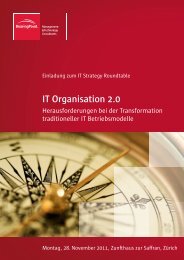Executive summary - BearingPoint
Executive summary - BearingPoint
Executive summary - BearingPoint
Create successful ePaper yourself
Turn your PDF publications into a flip-book with our unique Google optimized e-Paper software.
4 th Supply Chain Monitor<br />
<strong>BearingPoint</strong><br />
Operational trends<br />
Eco-design: a must for the development of activities<br />
"80% of the environmental impact of a product is<br />
determined during its design" (German Environment<br />
Agency). We believe this percentage is underevaluated.<br />
Anticipating the environmental footprint of<br />
a product from the very first steps of its development<br />
(eco-design approach) is an essential element<br />
to take into account, considering the actions of<br />
markets, competitors and national and supranational<br />
authorities.<br />
Attentive to the new eco-responsible desires of their<br />
clients, some companies don’t hesitate anymore in<br />
selling an eco-designed product at a higher price to<br />
gain market shares. Although few of the interviewed<br />
companies claim having taken the path of eco-design,<br />
results are very encouraging for those that did as<br />
the main objectives they had when beginning are<br />
generally reached: compliance with laws, brand image<br />
improvement, meeting final customer’s requirements<br />
or recycling optimisation.<br />
Procurement: the green requirements in sustainable<br />
procurement<br />
Beyond requirements that procurement departments<br />
have traditionally been promoting over the years,<br />
such as the respect of work conditions and nondiscrimination,<br />
new issues arise about reinforcing<br />
environmental requirements towards suppliers.<br />
According to the results of our survey, two thirds<br />
of companies adopted or plan to adopt a green<br />
policy for their purchases. This approach enables<br />
better compliance with existing norms (e.g. REACH),<br />
improvement of brand image for consumers and better<br />
ranking by non-financial notation organisations.<br />
Buyers are preferably choosing suppliers with<br />
certified processes (ISO 14001 for instance), but there<br />
is more in the balance: companies also encourage<br />
suppliers who have a low raw material consumption,<br />
controlled emissions and pollution levels and raw<br />
material tracking. Furthermore they tend to select<br />
products made out of a large proportion of recycled<br />
and recyclable materials, and stamped by reliable<br />
eco-labels (Energy Star for instance being the most<br />
recognised label in the energy consumption field).<br />
Lean manufacturing at the time of green Supply Chain<br />
Cost-cutting culture and industrial know-how have<br />
been associated for several decades. For 5 to 10<br />
years, depending on the sectors, broadcasting and<br />
implementation of "lean" techniques and practices<br />
have known a further development.<br />
The first intentions in the 80s were cost-cutting<br />
through the hunt of all kinds of waste and through the<br />
use of the minimum resources: the expected result<br />
was operational efficiency. They remain unchanged,<br />
but are now promoted inside the company as an<br />
environmental necessity, and enable to give a more<br />
practical view of the company actions.<br />
Logistics: classical optimisation approaches, source of<br />
green quick wins<br />
In the past, classical optimisation was driven by costs<br />
and lead time. Nowadays a third dimension appears:<br />
the environmental impact. Especially the increases of<br />
energy costs in 2008 and the European Union Emissions<br />
Trading Scheme (EU ETS) drove the need for logistics<br />
optimisation. There are various ways to optimise from<br />
processes until technical improvements. The good<br />
news is every company can launch logistics initiatives<br />
to reduce environmental impacts. And quick wins in<br />
green projects do exist.<br />
Carbon footprint: measurement as a prerequisite for<br />
the optimisation<br />
Defining a baseline by measuring an initial carbon<br />
footprint is the prerequisite for setting up realistic<br />
reduction goals. More and more companies realise<br />
that virtual, non hard fact based reduction goals cause<br />
more harm than good. It highlights the actions to<br />
carry out in order to better control the environmental<br />
impact and optimise operational costs. 80% of the<br />
companies that measured their carbon footprint<br />
identified immediately applicable improvement<br />
initiatives that led to concrete improvements, for<br />
instance to diminish resources consumption and get<br />
rid of waste.<br />
Beyond action, communication<br />
Communication is also part of the economical<br />
stakes of a green Supply Chain. Communicate on<br />
the environmental improvements made for the "Last<br />
Mile" is a strong competitive argument for a logistics<br />
contractor. That way the suppliers can give value to<br />
their know-how and improve their carbon footprint<br />
without degrading their performances.<br />
Showing that your company strategically cares about<br />
the environment through the definition of its products<br />
use, or through the choice of its components,<br />
suppliers, packaging, distribution network, has<br />
become an asset… and will most certainly be a survival<br />
need tomorrow! ■<br />
Green…Supply…Chain:…from…awareness…to…action…<br />
Companies committed to measuring their carbon footprint<br />
* Germany, Switzerland and Austria<br />
Source: <strong>BearingPoint</strong>, Green Supply Chain Monitor, 2010-2011<br />
10 11<br />
60%<br />
40%<br />
20%<br />
0% Scandinavia United<br />
Kingdom<br />
& Ireland<br />
40%<br />
30%<br />
20%<br />
10%<br />
0%<br />
GSA * France<br />
Benelux<br />
Companies that don't measure yet but intend to do it<br />
within 3 years<br />
Scandinavia United<br />
Kingdom<br />
& Ireland<br />
* Germany, Switzerland and Austria<br />
GSA * France<br />
Benelux<br />
Source: <strong>BearingPoint</strong>, Green Supply Chain Monitor, 2010-2011
















